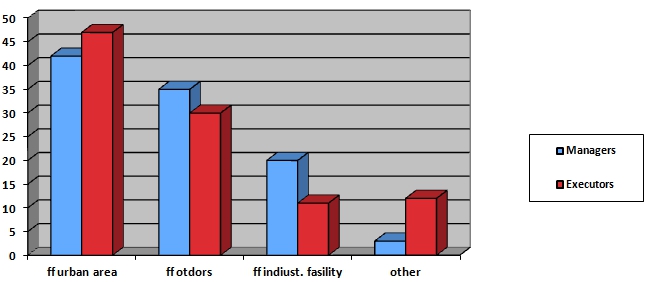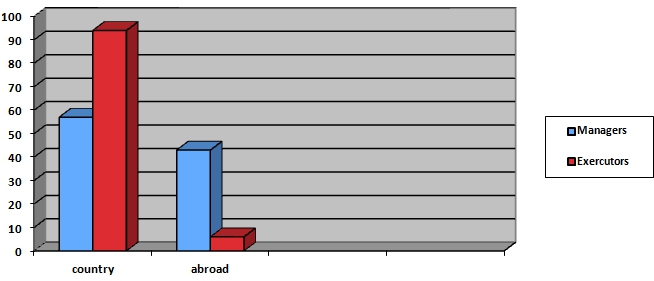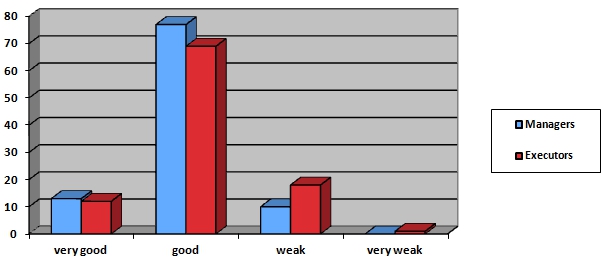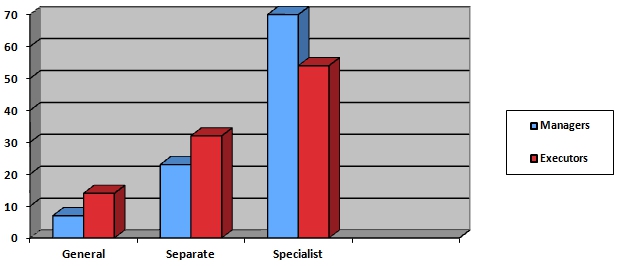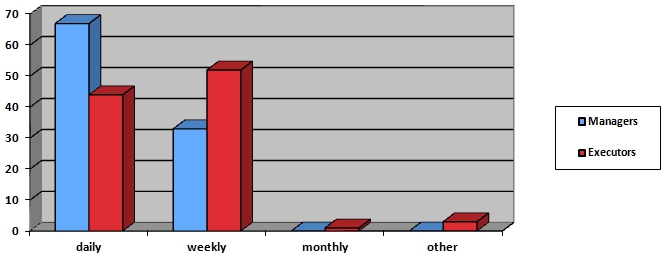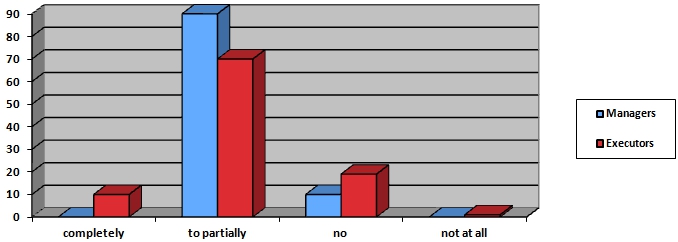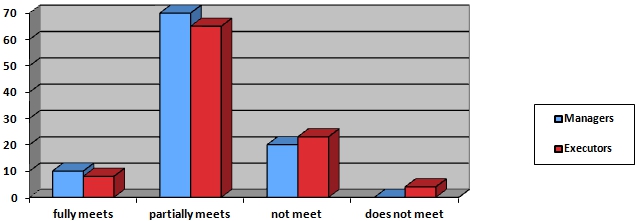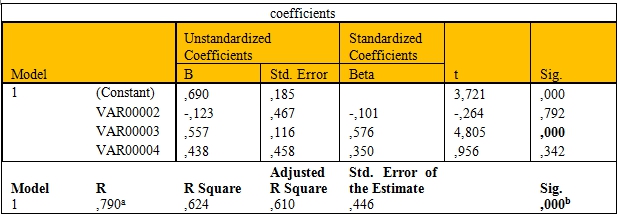EFFECTIVE TRAINING AND EQUIPMENT BRIGADE FIRE PROTECTION TO DEALING EFFICIENTLY WITH FIRES IN URBAN AREAS IN MACEDONIA
Solunchevski M.1, Petreski T.2, Cikarski T.3
1,2Assoc. Prof. PhD Ministry of Defence,
International Slavic University;
3Brigadier fire protection, Ministry of Defence
EFFECTIVE TRAINING AND EQUIPMENT BRIGADE FIRE PROTECTION TO DEALING EFFICIENTLY WITH FIRES IN URBAN AREAS IN MACEDONIA
Abstract
Firefighters are part of the system for protection and rescue in the Republic of Macedonia. Territorial fire units are the most important forces set for extinguishing and protection and rescue of people and property from fires in Macedonia. Brigade Fire Protection (BFP) is the largest fire fighting unit formed in Macedonia. Its effectiveness and efficiency is a mirror of the quality of Firefighters, and thus the protection and rescue of people and property from fires in Macedonia. Because BFP is dominant, it is situated on the territory of Skopje and whose priority should be capable of extinguishing fires in urban areas.
Training of firefighters and equipment of BFP equipment and material technical means (MTM) for extinguishing fires in urban areas are significant factors affecting its capability to extinguish fires in urban areas.
Keywords: training, equipment, fires, urban environment.
IntroductionBFP, being based in Skopje is the largest fire fighting unit in the RM. As a state fire fighting unit it is situated in Skopje, and it is functional for the whole territory.[1] According to her place and role in Firefighters rightly expect BFP be most effective fire unit to deal with fires in urban areas in Macedonia.
Many elements affect the so gorgeous efficiency. Also, on the ground that it faces a number of challenges that have yet to be overcome to increase its effectiveness. Because of that, the factors that affect the performance of BFP for dealing with fires in urban areas in the RM can be divided into two main groups: factors relating to BFP and factors relating to the ground / urban environment.
Important factors that affect the performance of BFP are: organizational structure, the availability of human resources (HR), the availability with equipment and MTM, human resource development for dealing with fires in urban areas etc.
Significant factors affecting terrain efficiency in extinguishing fires in urban areas are: spatial planning terrain urban landscaping, building regulation, communications etc.[2]
The research conducted by the employees of BFP in which were mentioned some factors as the most important factors that affect the performance of BFP are: training and exercise activities, HR and equipping BFP equipment and MTM.[3]
General training and exercisingThe training is a learning process which tends to transfer the knowledge to improve the skills and abilities to perform certain work and will change the attitude and behavior of the individual or group. The training was conducted according to a plan and training program.[4]
Exercise activities are aimed at fully training units for fast and precise execution of tasks in complex environments in peace, crisis, emergency and wartime. Exercise activities constitute applied training forces for protection and rescue.[5]
Some authors say that training and exercise activities are considered joint as well as HR training. According to Griffin, the HR management training consists of teaching the operational and technical workers to perform work for which they were employed, and the development consists of teaching managers of skills needed for running the organization now and in the future. Most organizations conduct regular training and development programs for managers and employees.
Different methods for training and development are available, but it seems the most important is the type of material for training and development. If the content of the training material is factual then we have programs for learning and teaching methods; if the content is interpersonal relationships then have a group discussion; if employees have to learn physical skills than need training on the job or in environments similar to real etc.[6]
According to Smileski: Training and exercise activities are part of the development of human resources, which are considered as a component of human resources and is a function of the external changes that require employees to effectively and efficiently meeting customer requirements and internal changes in individuals who spontaneously occur as experiential learning, which increases the working and creative capacity of each individual.[7]
For the training and development, effort of an organization to facilitate learning by staff skills and behaviors related to work is planned. The advantage is that it is training at the work place because it is cheaper and has easy transfer of learning at work.[8]
Training for fire protection in the European countries is required. It is performed in their own centers or abroad. The training of firefighters in European elite firefighting unit includes:
- Introductory training
- Periodic refresher training knowledge
- Training to support people in carrying out their duties to protect against fires
- Training for competence.[9]
Training for protection and rescue, and consequently for fire protection in the Republic of Macedonia is mandatory. The training is divided into basic and additional specialized training for acquiring the necessary technical and other knowledge to perform tasks in the system protection and rescue. The content and manner of conducting the training is conducted in accordance with curricula and training programs for protection and rescue adopted by the director of the Directorate for Protection and Rescue.[10]
The program for training of managers of action for fire fighting and rescue of people and property consists of two parts:
- Rules that determine fire protection
- Vocational technical part
- fire prevention
- firefighting tactics
- fire technique[11]
Asset is brought into direct contact with the place and space where it starts the process of burning and by its action permanently stops burning called means of extinguishing the fire. A means of extinguishing the fire can be divided according to: origin and the method of obtaining, the aggregate condition, purpose, the effect of the action etc.[12]
Equipment and MTM to extinguish fires can be divided according to the type of fire: equipment and MTM for extinguishing forest fires, industrial fires, fires in urban areas and so on. Equipment and MTM to extinguish fires in urban areas comprise: personal fire protection equipment, appliances extinguishing, fire hoses and pipes, fire stairs, equipment rescue height equipment to work with hazardous materials, fire protection vehicles, fire vehicles of fire.[13]
The Ministry of Environment and Physical Planning in accordance with the Director of the Directorate for Protection and Rescue prescribe a list of substances and the method and criteria for use and storage of substances used for fire protection.[14]
Minimum equipment of the MTM that should have BFP prescribed by separate regulations is adopted by the Directorate for Protection and Rescue. According to the said Rules of equipment and MTM who should possess BFP are: firefighting vehicles with equipment, firefighting tanks, SUVs, vans, trailers, motor pumps, electric pumps, power units and more.[15]
Based on the Regulation a material composition of BFP is prepared. BFP are equipped with equipment and material composition according to MTМ. This means: Personal equipment: Members of BFP are equipped with personal equipment. Collective equipment and technique. In collective equipment enters all the equipment used for the implementation of all operational-tactical tasks in fire fighting units. It is divided into fighting vehicles; apparatus for protection of respiratory organs; manuals means of fire; manual transmission vehicles and fire extinguishers; fire pumps; fire hoses, nozzles, dividers, water cannon and foam; fire stairs; technical equipment and tools; lighting equipment; communications equipment and more. Special equipment and technology. Here enters equipment and technique used in specific conditions of intervention such as: аutomobile stairs; protective equipment to protect against high temperatures and others.[16]
Results and analysis of the results from the research in the brigade for fire protectionIn 2014 a research was conducted on the organizational structure of BFP and its readiness to effectively and efficiently deal with fires on the territory of Skopje. In addition we will present some of the results and analysis of the results pertaining to training, exercises and equipping BFP equipment and MTM.
1.Sample of the research
The sample consisted of 115 respondents (30 heads of organizational units for fire protection and 85 employees- executors in organizational units for fire protection).
The samples for the heads is composed of all managers in the organizational units in BFP while the sample for executors was made systematically and is comprised of each second in the list of employees - executors in BFP.
2.Results and analysis of training and exercising of firefighters in the brigade for fire protection
In BFP given the nature of the work requires training on the job or in environments similar to the real. It is practical training and exercising of firefighters. Training, types of training, training of firefighters, and the intensity of exercise firefighters in BFP shown through multiple images (graphs)
Fig 1 - Types of training for fire fighting
From the Figure 1 you can see that the highest percentage of firefighters said they received training for fire fighting in urban areas, and 42% of managers and 47% of the executors. However most of the firefighters 58% of managers and 53% of the executors received training for fire fighting in urban areas, but other types of training.
Fig.2 - A place where firefighters have attended training
The obtained parameters of Figure 2, point to different attendance of training to managers and executors. Most training is visited in the country, but the percentage of managers and executors is different. Managers 57% attended training in the country and 43% abroad, while 94% of executors in the country, and only 6% abroad.
Fig. 3 - Assessment conducted training
According to the parameters of Figure 3 is similar to the attitude of the management and the executors on the question of training of firefighters in the organizational unit of BFP. Most managers positively assessed training: 13% very good and 77% good, 10% as opposed to that training is assessed as weak. Similar assessment and executors: 12% very good and 69% good, versus 18% and 1% low and very low.
Fig. 4 - Needed training to deal with fires in urban areas
To effectively deal with fires in urban areas the highest percentage of firefighters think they need specialized training. For specialized training reported 70% of management and 54% of executors. If we compare with Figure 1 can be seen that almost match the percentage of people who have not attended training for fire fighting in urban areas, with firefighters who wish to attend specialist training in the future.
The practical part of the training is commonly realized through exercise activities. On the next picture you can see how often conducted exercise activities with firefighters in the BFP.
Fig. 5 - Intensity conducting exercises
In the obtained parameters of Figure 5 can be seen that between the heads and executors are different interpretations about exercise activities. Managers reported that 13% daily, 40% weekly, 27% once a month and 20% rarely. The executors are divided, 30% reported that they conduct daily exercise activities, 25% once a week, 18% once a month, 26% rarely and only 1% do not visited exercise activities.
Firefighters do not agree with this situation and consider the need to intensify the exercise activities.
Fig. 6 - Statement intensity of conducting exercises in the future
Get indicators of Figure 6, with 67% of managers, that need daily exercise activities, and 33% for the implementation of exercises once a week. Most executors 52% indicate the need to perform the exercises once a week, and 44% believe that they should be performed daily.
3.Results and analysis of equipment Brigade Fire Protection equipment and material-technical means
As for the equipment of the fire brigade equipment and MTМ negative opinions among respondents.
Fig. 7 - Equipment of Brigade Fire Protection equipment and material technical means
On the performance of Figure 7, 90% of managers and 70% of the executors consider their organizational units part is equipped with equipment and MTМ. Since 90% of managers believe that organizational units is partially equipped and 10% is equipped with facilities and MTМ. The opinion of the executors is more positive. Only 70% believe that organizational units is partially equipped 20% not at all not. Only 10% of executors believe brigade is fully equipped with equipment and MTМ.
Fig. 8 - The quality of equipment and material technical means
According to the indicators in Figure 8 the biggest number of respondents is of the opinion that the equipment and MTS partially meet standards. Since 70% of managers believe that the equipment and MTS partially meet the standards and 20% did not meet the standards. Since executors 65% think that partially meet standards and 23% did not meet. Only 8% said they fully meet the standards.
4.Relations of connection and influence in extinguishing fires (regression analysis)
The criteria for defining the relationship and impact of research made by extracted average value of indicators summarized in the assessment in both SUP samples of respondents (managers and executives in the OE, VAR00001R and VAR00001I). For the predictorcal indicators or independent variables that define the relationship and influence in Soup sample managers selected three variables:
- VAR00002R / I - evaluation of training fire fighters in OE defined by the parameters obtained in the managers (R) and executors (I) in the organizational units;
- VAR00003R / I - Evaluation of exercise activities are conducted in OE, defined indicators received the managers and executors
- VAR00004R / I - value of MTS equipment and extinguishing fires in urban areas, defined by the parameters obtained with managers and executors.
According to the data (Table 1), it can be noted that in view of the descriptive statistical indicators recorded the number of respondents (N), mean (M) and standard deviation (Sd). Inspection in the table of the assessment can be concluded that no significant deviations of the values obtained from the mean.
The review of the correlation matrix (Table 2) shows us the connection between all indicators, where according to Pearsons’ constant notes coefficient is the correlation of high and medium level. The results of the performed regression analysis (Table 3) reveal that the coefficient of multiple correlation or correlation of the system variables of the predictoric (VAR00002R- assessment training of firefighters in RE; VAR00003R- assessment by exercise activities performed in the OE and VAR00004R- evaluation of MTS equipment and extinguishing fires in urban areas) with criteria (VAR00001R- do you think organizational / formational composition of RE meets the needs for fire protection in urban areas) is R = .82 and the prediction coefficient R2 = .68, which means it explains common variability of about 68%. This link points to the statistical significance level of P = .000 (Sig. = 0,000). The remaining 32% in explaining the total variability remains of some other factors and indicators that are not the subject of our research. Besides the common connection of the system individually statistically significant criteria noted indicator VAR00002R- assessment training of firefighters in OE with a positive impact (BETA = 0,559), which is significant at the level of p-level = .003, and VAR00003R- assessment of exercise activities are conducted in a positive impact OE (BETA = 0,463), which is a significant level of p-level = .003.
Table 1
Table 2
Table 3
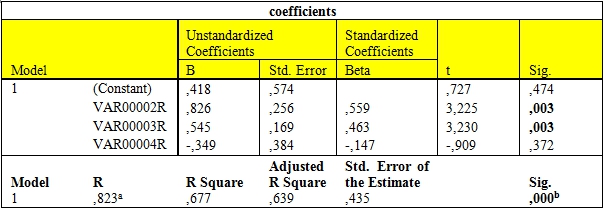
According to the data (Table 4), it can be noted that in view of the descriptive statistical indicators recorded the number of respondents (N), arithmetic middle (Maen) and standard deviation (Sd). Inspection in the table of the assessment can be concluded that no significant deviations of the values obtained from the mean. The review of the correlation matrix (Table 5) points out the connection between all indicators, where according Pearson’s coefficient notes is the correlation of high and very high. The results of the performed regression analysis (Table 6) reveal that the coefficient of multiple correlation or correlation system of predictor variables (VAR00002I- assessment training of firefighters in OE; VAR00003I- assessment by exercise activities performed in the OE and VAR00004I- evaluation of equipment and MTS for extinguishing fires in urban areas) with criteria (VAR00001I- do you think organizational / formational composition of OE meets the needs of protection from fires in urban areas) is R = .79 and the prediction coefficient R2 =. 62, which means it explains common variability with about 62%. This link points to the statistical significance level of P = .000 (Sig. = 0,000). The remaining 38% in explaining the total variability remains of some other factors and indicators that are not the subject of our research. Besides the the common connection of the system individually statistics significant impact on the criteria noted VAR00003R- indicator assessment by exercise activities are conducted in a positive impact OE (BETA = 0,576), which is significant at the level of p-level = .000.
Table 4

Table 5

Table 6
The correlation matrix in the assessment between selected indicators: VAR00001R / I- how organizational / formational composition of OE meets the needs for fire protection in urban areas; VAR00002R / I- assessment training of firefighters in OE, defined indicators received the heads and perpetrators in OE; VAR00003R / I- assessment by exercise activities are conducted in OE, defined indicators received the heads and perpetrators and VAR00004R / I- assessment by MTS equipment and extinguishing fires in urban areas, defined by the parameters obtained in the heads and prosecutors determined is an association between indicators. Pearson’s coefficient correlation spotted connection f the middle and high level in SUP sample of managers, while SUP sample of employees observed a correlation of high and very high.
To determine the interconnection of the applied system of indicators for training, readiness and equipment (VAR00002R / I- assessment training of firefighters in OE, defined indicators obtained in the heads and perpetrators in OE; VAR00003R / I- evaluation of the exercise activities performed in OE, defined indicators obtained in the heads and perpetrators and VAR00004R / I- assessment by MTS equipment and extinguishing fires in urban areas, defined by the received performance in the managers and executors) with organizational and formational structure (VAR00001R / I-how organizational / formational composition of OE meets the needs for fire protection in urban areas) is performed regression analysis which concluded that there is no statistically significant relationship and influence of the applied system of predictors with the criteria in both samples SUP. Analyzing the relationship of individual indicators can be noted that, with two independent parameters (VAR00002R- assessment training of firefighters in OE; VAR00003R- assessment by exercise activities are conducted in OE) on criteria of SUP sample of managers there individually positive impact secondary level, while SUP sample of executives noted individually positive Impact criteria indicator (VAR00003I- assessment by exercise activities are conducted in OE) of average.
Of the performed research noted that:
- The level of training of firefighters is the a solid level, although in need of improvement, but detected the need of specialized training
- Get statements indicate the need for exercises with increased intensity and regular ongoing activity.
- According to statements given equipment partially meets basic standards for fire extinguishing.
Brigade fire protection based in Skopje is the largest fire fighting unit in the Republic of Macedonia. As Republican fire unit extinguish fires in the City of Skopje, and the whole territory. Its efficiency affects the protection of the population and material addressing fire in urban environments. The most important factors affecting its performance are: effective training and equipping of the brigade equipment and MTM.
The research done in the firefighters categorized in two samples SUP: managers and executives. For predictor indicators or independent variables that define the relationship and impact in SUP samples selected three variables: training, exercise activities and equipment with equipment and MTS to extinguish fires in urban areas.
To determine the interconnection of the applied system of indicators for training, readiness and equipment, conducted a regression analysis that detect a statistically significant relationship and influence of the applied system of predictors with the criteria in both samples SUP.
Research shows that firefighters need specialized training for extinguishing fires in urban areas and intensification of exercise activities of daily and weekly execution. Also, there is a need for quantitative and qualitative equipping Brigade fire protection with efficient equipment and MTM to comply with European standards.
References
- Grifin R., Principles of Management, A&M,University Texas, USA, (Translation: R. Griffin (2010) Principles of Management, Genex, the book.)
- Daft R., (2011) Management, Genex, Kocani (translation)
- Law firefighting, Official Gazette No. 67/04 and 56/2014
- Law on construction, Official Gazette, no. 39/2006 and 86/2009
- Law on Protection and Rescue, Official Gazette, no. 36/2004
- Law on Spatial Planning, Official Gazette No. 70/2013 (Consolidation)
- Law on Safety of Traffic roads, Official Gazette No. 54/2007
- Kelvin, C., (2001) Matering Human Resource Management, Pelgrave,
- Karabas D (2009) Protection against fire and blast, higher technical school;, Novi Sad
- Мaterial composition of BFP, (2006) BFP, Skopje
- Neskoski H., (2012) Fire protection in urban environments, fire union, Macedonia, Skopje.
- Rulebook on the rules for conducting the service, and the minimum criteria for accommodation, equipment and technical means for extinguishing fires that should have firefighting units, Official Gazette No. 19/2006,
- Program to training managers action extinguishing and rescue of persons and property, Official Gazette, no. 87/2006.
- Smilevski C. and others. (2007), human resources management, (pilot version), Detra Skopje
- Solunchevski, M., (2008) Management of human resources in the system for protection and rescue, Mycenae, Bitola
- Solunchevski, M., (2014) Civil Protection (internal textbook), MSU-FBI Sveti Nikole Bitola.
- Cikarski, T., (2015) Organizational structure of the brigade for fire protection and its readiness to effectively and efficiently deal with fires on the territory of Skopje, master's thesis, MSU, FBI, fire protection, Bitola.
- http://www.london-fire.gov.uk/
- http://pravdiko.com
[1] Firefighting Act, Official Gazette, no. 67/2004, Article 5.
[2] Law on Spatial Planning, Official Gazette No. 70/2013 (Consolidation), Law construction, Official Gazette, no. 39/2006 and 86/2009, Law on Traffic Safety on the roads, Official Gazette No. 54/2007 (www.pravdiko.com)
[3] Cikarski, T., Organizational structure of the brigade for fire protection and its readiness to effectively and efficiently deal with fires on the territory of Skopje, master's thesis, MSS, FBI, fire protection, Bitola, 2015th
[4] Kelvin, C., (2001) Matering Human Resource Management, Pelgrave, pp.150.
[5] Solunchevski, M., (2014) Civil Protection (textbook for internal usage), MSU-FBI Sveti Nikole Bitola.
[6] Grifin R., Principles of Management, A & M, University Texas, USA, (Translation: R. Griffin (2010) Principles of Management, Genex, Kocani.) pp 202.
[7] See beyond: Smilevski C. and others. (2007), human resources management, (pilot version), Detra Skopje pp.111-132
[8] Daft R., (2011) Management, Genex, Kocani (translation) pp 399
[9] http://www.london-fire.gov.uk/RegulatoryReformOrder2005.asp
[10] Law on Protection and Rescue, Official Gazette, no. 36/2004, Article 121.
[11] Program to training managers action extinguishing and rescue of persons and property, Official Gazette, no. 87/2006.
[12] Neskoski H., (2012) Fire protection in urban environments, FFA of Macedonia, Skopje, pp.61.
[13] Karabas D (2009) Protection against fire and blast, VTSHSS, Novi Sad,pp.25.
[14] Firefighting Act, Official Gazette, no. 67/2004, Article 44
[15] Rulebook on the rules for conducting the service, and the minimum criteria for accommodation, equipment and technical means for extinguishing fires that should have firefighting units, Official Gazette No. 19/2006, Articles 53-56.
[16] See beyond: Мaterial composition of BFP, (2006) BFP, Skopje

